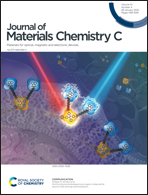Bi3+ doping in 1D ((CH3)3SO)PbI3: a model for defect interactions in halide perovskites†
Abstract
The recently described monodimensional hybrid pseudo-perovskite ((CH3)3SO)PbI3 exhibits complete Pb2+/Bi3+ miscibility in the B site. Heterovalent substitution imposes that charge-compensating defects are introduced in the lattice as well. This paper reports the energetics of point defects and the interaction between charge-compensating defects that occur upon Bi3+ doping in ((CH3)3SO)PbI3. Periodic DFT simulations were employed to analyze the formation energy of Pb2+ vacancies, (CH3)3SO+ vacancies, iodide vacancies, or the insertion of interstitial iodide ions. Solid solutions with a large Bi3+ content were modeled considering different charge compensation defects (Pb2+ vacancies, (CH3)3SO+ vacancies, and interstitial iodide) to consider electrical neutrality. Both the formation energy evaluation and the structural parameters after relaxation are in very good agreement with available experimental data (both X-ray diffraction and absorption spectroscopy), confirming that Pb2+ vacancies are indeed the primary ionic charge-compensation mechanism leading to solid solutions described by the formula ((CH3)3SO)3Pb3xBi2(1−x)V(1−x)I9 (0 < x < 1), where V indicates a B site vacancy. As a consequence of the complete miscibility, the defect concentration at intermediate compositions is considerable, and it is probably responsible for various peculiar structural effects observed, e.g., in ((CH3)3SO)3Pb0.99Bi1.34I9, which are related to short-range order phenomena in the chain composition. Atomistic simulations were then carried out to estimate defect–defect interactions as a function of their respective positions inside the linear PbI6/BiI6 octahedral chains. The resulting bond energies for atom pairs and triads effectively explain the relative stability of defect clusters. This approach is expected to shed light on the short-range order in this class of doped materials, but it can be extended to other structures as well. The understanding of defect structures and control of structural and electronic properties have implications for the engineering of doped materials, which find vast applications in optoelectronic devices.



 Please wait while we load your content...
Please wait while we load your content...